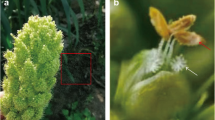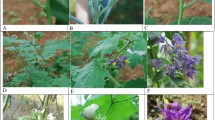Abstract
In connection with crop improvement strategies for marginal regions it has been proposed to increase the outcrossing rate in barley which would presuppose high and persistent pollen viability to ensure successful cross fertilisation. The present study was designed to investigate the viability of mature pollen from extruded and non-extruded anthers of cultivated and wild barley (Hordeum vulgare ssp vulgare and ssp spontaneum, respectively) in comparison with the closely related but obligatory outcrossing species H. bulbosum. Pollen viability (PV) was assessed employing the p-phenylenediamine-peroxidase-test on pollen derived from spikes or anthers immediately after collection and after treatment at 20, 30 and 40 ∘C for 1, 2, 4, 8 and 16 h. The latter treatment was interposed after 8 h by a 10 h period of darkness at 12 ∘C and thus called 26 h treatment, consecutively. Initial PV was high with 98% across all genotypes and even at 40 ∘C did not fall below 80% after 8 h. After the 26 h treatment, PV of two H. vulgare genotypes originating from semi-arid regions and of H. bulbosum fell below 60% while the other genotypes retained a PV of > 80%. Viability of pollen of extruded anthers in H. vulgare ssp. spontaneum was on average slightly but significantly lower than PV of non-extruded anthers but still remained above 90%, even after the 26 h treatment at 40 ∘C. Pollen viability of the outcrossing species H. bulbosum ranged on a very similar level as PV of H. vulgare. Results indicate that pollen of H. vulgare retains a sufficiently high level of viability to ensure successful cross-fertilisation over a period of at least 26 h even at high temperatures of up to 40 ∘C.
Similar content being viewed by others
References
Abdel-Ghani, A.H., H.K. Parzies, H. Omary & H.H. Geiger, 2004. Estimating the outcrossing rate of barley landraces and wild barley populations collected from ecologically different regions of Jordan. Theor Appl Genet 109: 588–595.
Abdel-Ghani, A.H., H.K. Parzies, S. Ceccarelli, S. Grando & H.H. Geiger, 2005. Estimation of quantitative genetic parameters for outcrossing-related traits in barley. Crop Sci 45: 98–105.
Brown, A.H.D., D. Zohary & E. Nevo, 1978. Outcrossing rates and heterozygosity in natural populations of Hordeum spontaneum Koch in Israel. Heredity 41: 49–62.
D'Souza, L., 1970. Untersuchungen über die Eignung des Weizens als Pollenspender bei der Fremdbefruchtung, verglichen mit Roggen, Triticale und Secalotriticum. Z. Pflanzenzüchtg. 63: 246–269.
Einfeldt, C.H.P., 1999. Effects of heterozygosity and heterogeneity on yield and yield stability of barley in dry areas of North Syria. Ph. D. Thesis. University of Hohenheim.
Einfeldt, C.H.P., S. Ceccarelli, S. Grando, A. Gland-Zwerger & H.H. Geiger, 2005. Heterosis and mixing effects in barley under drought stress. Plant Breed 124: 350–355.
FAO, 2000. FAOCLIM-2 World-wide agroclimatic data base, Version 2.01.
Fritz, S.E. & A.J. Lukaszewski, 1989. Pollen longevity in wheat, rye and triticale. Plant Breed 102: 31–34.
Gupta, S.K., D. Singh & S.C. Sharma, 2000. Genetic variability for allogamic traits in barley (Hordeum vulgare L.). Agric Sci Digest 20: 1–4.
Hartung, J., B. Elpelt & K.H. Kloesener, 1986. Statistik: Lehr- und Handbuch der angewandten Statistik. Oldenbourg Verlag, München, Wien.
Issarakaraisila, M. & J.A. Considine, 1994. Effects of temperature on pollen viability in mango cv. ‘Kensington’. Ann Bot 73: 231–240.
Khatum, S. & T.J. Flowers, 1995. The estimation of pollen viability in rice. J Exp Bot 46: 151–154.
Lozán, J.L. & H. Kausch, 1998. Angewandte Statistik für Naturwissenschaftler. 2. Auflage. Blackwell Wissenschafts-Verlag Berlin, Wien.
Mayer, M., A. Gland, S. Ceccarelli & H.H. Geiger, 1995. Comparison of doubled haploid lines and F2 bulks for the improvement of barley in the dry areas of North Syria. Plant Breed 114: 45–49.
Nevo, E., 1992. Origin, evolution, population genetics and resources of wild barley, Hordeum spontaneum, in the Fertile Crescent. In: P.R. Shewry (Ed.), Barley: Genetics, Biochemistry, Molecular Biology, and Biotechnology. CAB-International Wallingford UK, pp. 19–43.
Parzies, H.K., W. Spoor & R.A. Ennos, 2000. Outcrossing rates of barley landraces from Syria. Plant Breed 119: 520–522.
Rodriguez-Riano, T. & A. Dafni, 2000. A new procedure to asses pollen viability. Sex Plant Reprod 12: 241–244.
SAS Institute Inc., 1997. SAS/STAT Software: Changes and Enhancement through Release 6.11. SAS Institute Inc., Cary, N.C.
Scott, P. & R.L. Lyne, 1994. Initiation of embryogenesis from cultured barley microspores: A further investigation into the toxic effects of sucrose and glucose. Cell Tiss Org Cult 37: 61–65.
Schoper, J.B., R.J. Lambert & B.L. Vasilas, 1987. Pollen viability, pollen shedding, and combining ability for tassel heat tolerance in maize. Crop Sci 27: 27–31.
Schubert, R. & G.H. Wagner, 2000. Botanisches Wörterbuch. 12. Auflage. Verlag Eugen Ulmer Stuttgart.
Shivanna, K.R. & N.S. Rangaswamy, 1992. Pollen biology. A laboratory manual, pp. 9–20. Springer Verlag, New York.
Stanley, R.G. & H.F. Linskens, 1985. Gewinnung und Verwendung und Lagerung. In: R.G. Stanley, H.F. Linskens (Eds.) Pollen Biologie, Biochemie, Gewinnung und Verwendung. Urs Freund Verlag, Greifenberg/Ammersee, pp. 40–72.
Tuinstra, M.R. & J. Wedel, 2000. Estimation of pollen viability in grain sorghum. Crop Sci 40: 968–970.
Welsh, J.R. & A.R. Klatt, 1971. Effects of temperature and photoperiod on spring wheat pollen viability. Crop Sci 11(6): 864–865.
Author information
Authors and Affiliations
Corresponding author
Rights and permissions
About this article
Cite this article
Parzies, H.K., Schnaithmann, F. & Geiger, H.H. Pollen viability of Hordeum spp genotypes with different flowering characteristics. Euphytica 145, 229–235 (2005). https://doi.org/10.1007/s10681-005-1167-5
Received:
Accepted:
Issue Date:
DOI: https://doi.org/10.1007/s10681-005-1167-5




